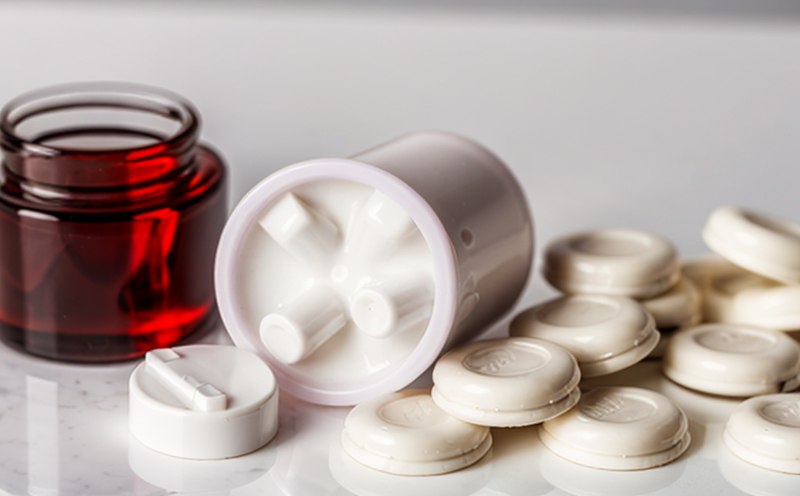pH of Pharmaceutical Solutions Test
The pH of pharmaceutical solutions is a critical parameter that significantly influences drug stability, dissolution rate, and overall efficacy. In the realm of pharmaceutical testing, ensuring accurate measurement of pH is crucial for quality control and compliance with regulatory standards such as USP (United States Pharmacopeia), ICH guidelines, and ISO international standards.
The importance of pH in oral solid dosage forms cannot be overstated. It affects the solubility and bioavailability of active pharmaceutical ingredients (APIs). A slight variation in pH can lead to significant changes in drug dissolution behavior, which ultimately impacts therapeutic outcomes. For instance, a high-pH environment might increase the solubility of poorly soluble drugs, enhancing their absorption. Conversely, an acidic pH may denature proteins or degrade sensitive compounds.
Testing pH is typically conducted using potentiometric sensors and pH meters that adhere to ISO standards for accuracy and precision. The process involves preparing a representative sample of the pharmaceutical solution under controlled conditions, such as temperature and humidity. It's essential to ensure that the sample is homogeneous before measurement to avoid misleading results.
The acceptance criteria for pH in oral solid dosage forms are stringent. According to USP Monograph 732, the pH range should generally fall between 4.5 and 8.5, although this can vary depending on the specific formulation. Deviations outside this range may indicate issues with drug stability or efficacy. Compliance officers must closely monitor these parameters during development and production to ensure consistency.
Accurate measurement of pH is not just about compliance; it also plays a vital role in R&D efforts. Understanding how different pH levels affect drug dissolution can inform formulation changes aimed at optimizing bioavailability. Quality managers rely on this data to make informed decisions regarding batch release, ensuring that only high-quality products reach the market.
The impact of pH variations extends beyond just compliance and R&D—it also influences patient safety and satisfaction. An incorrect pH in a medication could lead to reduced efficacy or even adverse reactions. Therefore, precise measurement is not merely an analytical task but a cornerstone of safe and effective drug production.
Industry Applications
In clinical trials, pH testing helps in understanding how different formulations behave under varying physiological conditions. This information is crucial for determining the optimal formulation that provides consistent therapeutic effects.
During formulation development, pH measurements guide adjustments to enhance solubility and stability of APIs, ensuring that the final product meets both regulatory and practical requirements.
In quality assurance, frequent pH testing ensures consistency across production batches. Any deviation from specified limits can be quickly identified and addressed, preventing potential batch rejections or recalls.
For formulation optimization, pH data helps in refining processes to improve drug release rates and enhance patient compliance by ensuring the product is palatable within its acceptable pH range.
The ability to accurately measure pH across various stages of pharmaceutical development and production underscores the importance of this service. It contributes directly to the reliability and safety of medications, a critical factor in maintaining public trust and regulatory approval.
Eurolab Advantages
At Eurolab, we pride ourselves on providing unparalleled pH testing services tailored specifically for oral solid dosage forms. Our expertise is rooted in decades of experience, ensuring that our clients receive accurate and reliable results every time.
State-of-the-art instrumentation: Utilizing the latest potentiometric sensors and pH meters, we guarantee precise measurements that meet or exceed international standards such as ISO 3696:1997. Our equipment is regularly calibrated to ensure consistency and accuracy.
Comprehensive testing services: We offer a full suite of pH testing for oral solid dosage forms, including initial formulation development through final product release. Our team of experts ensures that each step of the process adheres to strict guidelines.
Beyond just meeting standards, our services are designed to help clients innovate and optimize their products. We work closely with R&D teams to provide insights that can lead to breakthroughs in formulation science. Our commitment to excellence is reflected not only in our equipment but also in the expertise of our staff.
Customer Impact and Satisfaction
Enhanced compliance: By ensuring accurate pH measurements, we help clients meet stringent regulatory requirements such as USP and ICH guidelines. This reduces the risk of non-compliance penalties.
Improved product quality: Our services contribute to higher-quality products by identifying issues early in the development process. This leads to more consistent batch releases and reduced rework.
Patient safety: Accurate pH measurements prevent potential adverse reactions due to incorrect formulations, thereby safeguarding patient health.
R&D support: Our data-driven insights aid in the development of more effective and stable products. This supports innovation and enhances overall product quality.
We are committed to delivering exceptional service that exceeds our clients' expectations. Our focus on precision, reliability, and customer satisfaction ensures that every project we undertake is a success. Clients can rest assured that their pharmaceutical solutions will meet the highest standards of quality and compliance.





